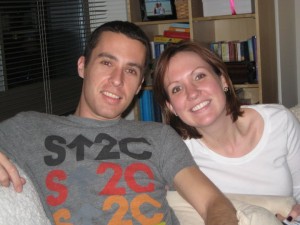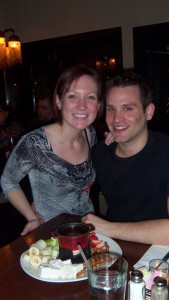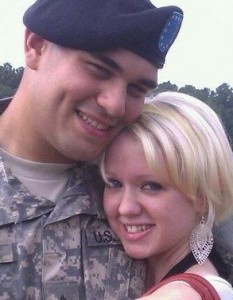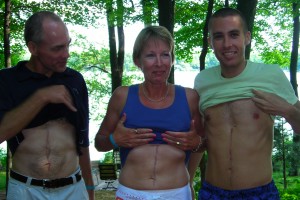
One of the most grim facts about Hereditary Diffuse Gastric Cancer (HDGC) is that the average age of onset is 38. Although stomach cancer of all kinds is now being seen in people at younger and younger ages, the most recent statistics still show an average age at diagnosis of 70 years.
Since the discovery of the CDH1 gene mutation in 1998, those with a family history are able to test for the mutation and consider prophylactic (preventative) total gastrectomy (TG) as an option. Stomach cancer is generally not known to be a young person’s disease, but for many of those who test positive for the CDH1 mutation in his or her 20’s, the decision to undergo TG is presented at this young age.
Contemplating one’s risk for cancer is not something on a person’s mind when in his or her 20’s. Yet at a time when they are thinking about advanced education, career options and generally finding their place in the world, more and more young adults with the CDH1 mutation are making the decision to have a TG.
Do I want to study biology or engineering? Is it time to get more serious with my boyfriend? Do I really want to know if I carry a gene that raises my risk for stomach cancer to over 80%?
Having this surgery at such a time in life creates a unique set of decisions for CDH1 carriers that may seem unfathomable to their peers. The first is whether or not to undergo genetic testing.

Simply making the decision to have a genetic test is a deeply personal choice. Some come to it easily, but for others it’s not so simple. For siblings Brian and Johanna Chelcun, who both had TG at the age of 26, the choice was made along with several other family members.
“I don’t really remember making the decision,” Johanna explains. “I just remember all of my family members were getting tested so I followed along.”
Indeed, it was their father’s battle with Stage IV gastric cancer and the passing of their grandmother in 1982 from gastric cancer which prompted the family to seek answers about a genetic link.
“My father was diagnosed with CDH1 after he and his mother were sick,” says Brian. “There was never a question of whether I should or would get tested; I knew automatically that I had to do it. Information is power.”
Jenn Lai of Hawaii, who chose to get tested in 2010 just prior to her senior year in college, shares Brian’s sentiment.
“The decision for me to get tested was a no-brainer. I like information, and I believe that the more information one has, the better equipped one is.“
Her mother had passed away at the age of 40 when Jenn was just 7 years old and she had long suspected a hereditary component to her mother’s illness. Jenn was considering going into medicine at the time and her inquisitive scientific nature led her to look for information. She quickly discovered HDGC and the CDH1 gene mutation and has been learning all she can about every aspect of the condition and making informed choices for her future.
Master’s Degree or Peace Corps? A job in Chicago or Atlanta? Stomach or no stomach?
As if choosing to have a genetic test isn’t stressful enough, if you receive a positive result there’s an even bigger decision to make. Current methods of surveillance cannot adequately detect the diffuse signet cell adenocarcinoma in an early stage. The only option, other than risking possible metastases and delay of diagnosis until the cancer is in an otherwise advanced stage, is TG. For many carriers of the CDH1 mutation, it isn’t a matter of if they will undergo TG, but when.
“I knew that at some point I would have to have the surgery,” says Johanna, “so for me the decision was mostly about the timing.”

Often the timing means making tough decisions about one’s education. Jenn Lai will be having her TG in March of this year, which is at an earlier age than most would choose. She found out about her CDH1 test result at around the same time she received positive news of a more encouraging nature.
“I had already applied for and received a Rhodes scholarship, which gives me the opportunity to study at Oxford University for up to 2 years. I was also in the midst of applying for MD/PhD programs, a program that on average takes 8 years to complete.”
She accepted placement in an MD/PhD program in March of 2011 and was able to defer her enrollment until she fulfills her scholarship at Oxford.
“I went to Oxford in the fall of 2011 and about a month in realized that I hadn’t yet fully come to terms with the information. I was lucky enough to get a deferral of my scholarship and I will now be getting the surgery done this year before returning to Oxford this fall.”
Both of these young women chose TG as a prophylactic measure as screening didn’t turn up any abnormalities. However, in Johanna’s case, post-operative pathology showed 32 cancerous lesions in her stomach.
Her brother Brian had a different outcome with pre-operative surveillance. While he had already made the decision to have a TG, results of pathology made him schedule the procedure sooner than he had originally planned.
“After an initial negative screening, tests were re-run and consultation was sought from a specialist in Portugal and my doctor determined that they had, miraculously, discovered a small precancerous lesion,” Brian explains. “So my surgery was not so much prophylactic. I had already met with surgeons and decided to have surgery in the near future, but once these re-run tests came back I moved up my surgery to just a few months later.”
For Laura McFetridge Ayala, scheduling surgery came down to an issue of cancer diagnosis as well. She had a TG in August of 2011 and is the third of her siblings to undergo this surgery while under the age of 27.
“Cancer was found during a biopsy after 5 months of knowing I had the [CDH1] marker,” explains Laura. “The detection did affect the timing of surgery because I am 22 and at the beginning of my life, a year after graduating college. So I wanted to do the surgery ‘before my life began’ in a way.”
After TG, most patients do not need chemotherapy or radiation. Surgery alone is often considered curative if it wasn’t simply preventative to begin with. At this point the immediate danger of cancer is avoided but there are other challenges ahead for a 20-something both during recovery and indeed throughout his or her entire life.
Your Jaeger-bomb days are over, kid! What do you mean you’re not entering the pie eating contest? You were the county champ three years in a row!
When in your twenties, a large part of your life is socialization. Whether you are going out to bars and restaurants or gathering at someone’s home, it may be hard to hide the fact that you do not eat or drink the same as your peers, especially within the first 6-12 months after surgery.

“This is definitely a challenging part of post-TG life,” says Johanna. “Most of the time I can eat and drink normally and don’t have to make excuses or talk about it. But there are definitely times when I have to say ‘no thanks’ to something because I know it will make me uncomfortable.”
Brian concurs that simply hanging out with peers can be troublesome.
“It was difficult and awkward, especially at first. I did not go out much for the first few months after surgery and didn’t drink alcohol for almost a year after surgery. I didn’t like to explain to anyone but my closest friends that I had had the surgery, which made making excuses difficult sometimes. The food part was ok, but making excuses about not drinking can be awkward because people assume you have an alcohol abuse problem or are doing it for religious reasons or other things, and if you say ‘no it’s a medical condition’ then that can really kill the conversation.”
Come here often? What’s your sign? Ever date a person with no stomach?
Not many people in their 20’s are aware that they may carry a mutation that will affect their lives for years to come. Social relationships, especially dating, can be tricky for a young adult hesitant to share their experience with new colleagues or even a prospective mate. Each individual has to decide both when they feel comfortable sharing their story and how much information to share.
“I was really lucky to find a great guy about 4 months after my surgery,” says Johanna. “I told him about my surgery on our 2nd date when we went to a wine bar for appetizers and dinner. He was, and always has been, extremely understanding and supportive. We’ve had a lot of talks about the future implications such as my risk for breast cancer and the genetic risks [for future children]”

Laura has had the full support of her husband from the time she was thinking about genetic testing through her surgery and present recovery.
“He understood what it all meant and talked to my sisters about it,” says Laura. “He knew what he was getting into and wanted to be there every step of the way. He came with me for my genetic testing.”
You might want to postpone that mountain-climbing trip to K2. And the X-Games are totally out of the question this year.
While everyone recovers differently and at a different pace after a TG, the surgery will not necessarily rob a young person of his or her physical capabilities. All it takes is time.
“I was limited at first, as expected, but started walking as soon as I got home from the hospital,” says Johanna. “I even went ice skating, carefully, about 2 weeks after my surgery. Slowly I became more active. I actually started working with a personal trainer at my gym who helped me get my energy and stamina back while doing exercises that didn’t stretch my abs too much. I ran a half marathon about 10 months after my surgery!”
Brian also has a half-marathon under his belt having gradually built up to it over the course of a year.
“I began running about 4 months after surgery and ran a 5K about 5 months after surgery. I’d say I’m about 95% back to before surgery. My one issue sometimes is staying hydrated since I can’t chug a glass of water.”
The physical adaptation a TG patient must undergo is enormous; it’s a whole new way of eating, drinking and maintaining physical health. But it also bears mentioning that emotional stress can take a toll on a young person facing genetic testing and then possible surgery.
“I had my TG about one week after my father passed away from HDGC.” Brian says. “I had a very difficult emotional recovery from both the surgery and his death.”
Laura also mentions that even though family members gave her advice about what to expect physically after this surgery she wasn’t fully aware of the emotional impact.
“I really struggle sometimes with feeling not myself, having anxiety and feeling a little depressed,” Laura says. “But everyone has different emotional issues with this surgery.”

Those words are very true. Everyone responds to this surgery differently whether the issues are mental, physical or emotional. Cancer can be devastating to all families. It can be more so to CDH1 families as there are often several family members who have passed away from gastric cancer and others who face the same surgery.
The up side of this, if you can call it that, is that a CDH1 carrier has the built-in support of their family members who have met this challenge with success and can be an invaluable source of information, advice and support.
The NSFC website has a special place for young people facing CDH1 and HDGC on their discussion forums. If you are new to this process or have been through it, consider creating an account and starting a dialogue. Our Community is a great way to connect with peers who face the same challenges you do.
Johanna Chelcun is a physician’s assistant and assistant professor at the Quinnipiac University PA program in North Haven, Connecticut
Brian Chelcun attends law school in New York City and has recently passed the 3rd anniversary of his TG.
Jenn Lai will have her TG in March of this year and then pick up her studies in the fall. You can keep up with her process and progress on her blog, gastronomically speaking.
Laura McFetridge Ayala is adapting to both not having a stomach and being a newlywed. She currently lives in Pennsylvania.